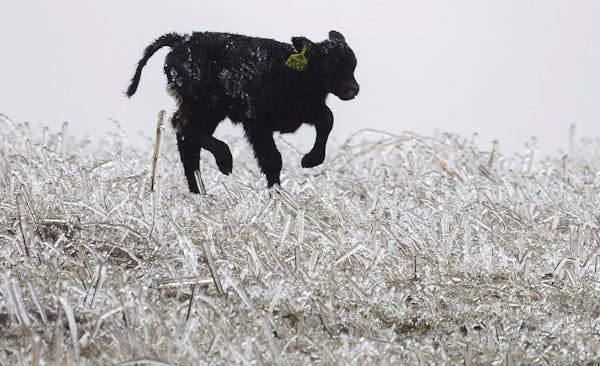For the second year in a row, winter has overstayed its welcome in Minnesota.
An intense 48-hour snowstorm that began moving northeast across the state Wednesday is expected to dump 2 feet of fresh, heavy snow on much of the southwestern part of the state by early Friday, with 8 to 14 inches possible in the Twin Cities metro area.
Minneapolis and St. Paul schools, along with several Twin Cities suburban districts, have called off classes for Thursday.
High winds will make the storm even more dangerous, the National Weather Service and state Department of Transportation warned.
A blizzard warning is in effect until 10 p.m. Friday for southwestern and south-central parts of the state, including the cities of Morris, Willmar, Marshall and St. Cloud. A winter storm warning is in effect for a much larger swath of the state, including the Twin Cities metro area.
By Wednesday night, heavy snowfall and fierce winds were making travel difficult to impossible in much of the state, and conditions were expected to get worse Thursday. "Expect many roads to become impassable overnight across western and west-central Minnesota," the NWS tweeted.
MnDOT advised no travel west and south of the Twin Cities. Interstate 35 between Faribault and Medford, where the snow had caused dozens of crashes, was closed for several hours Wednesday.
The State Patrol reported that from 8 a.m. to 9:30 p.m., there were 244 crashes statewide, 34 of them with injuries, as well as 212 vehicles spinning out or sliding off the road and 18 jackknifed semis.
By Wednesday night, snowfall amounts reported to the NWS included 7 inches in New Prague, 6.8 in Hutchinson, 6 in Faribault, 5.9 in New Ulm and Northfield, 5.6 in Kenyon, 5.2 in Hastings, 5 in Bloomington and Owatonna, 4.5 in Mankato, 4.3 in Rochester, 4.3 in Maple Grove, 4.5 in St. Paul and Mankato, 4.2 at the Minneapolis-St. Paul International Airport, and 4 in Winona.
The NWS predicted that by the time the storm wraps up Friday morning, the metro area will have a grand total of 8 to 14 inches of new snow.
Snow, rain, more snow
Bill Borghoff, lead forecaster at the NWS' Chanhassen office, said metro residents will wake up to 6 or 7 inches of snow Thursday, with precipitation changing to sleet and rain later in the day, and then to snow again late Thursday and early Friday.
To add insult to injury, the NWS reported that gusting winds strong enough to bring down tree branches were expected Thursday. Winds from the east could exceed 40 mph in the Twin Cities and 50 mph outside the metro area.
Snow will be slower to arrive in northeastern Minnesota, but that area won't be spared, said NWS meteorologist Brent Hewett. Spots along the I-35 corridor from the Twin Cities to Duluth are expected to get 10 to 15 inches by Friday afternoon.
Southeastern Minnesota was hit by a heavy band of snow at midday Wednesday, but will get fewer inches of snow than other areas by the time it all ends, Hewett said.
Temperatures were expected to climb into the 40s over the weekend, still about 10 degrees below average for this time of year and chilly enough to slow the melting process.
Water levels in major rivers will rise but were not expected to exceed last week's crest, Hewett said. With ice off the rivers, ice jams won't add to the problem either.
"Snow is one of the best-case scenarios" for avoiding flooding, he said. "If we got rain, we'd be a lot worse off."
Another April to remember
It was just a year ago this month when 15.8 inches of snow fell in the Twin Cities. At the beginning of April last year, the metro area received 9 inches of snow. A few days later a massive storm hammered the state on a mid-April Saturday.
Those two snowstorms placed among the Top 10 recorded in April in the metro area over the last 128 years. Whether this year's snow will make the Top 10 remains to be seen, Hewett said.
"We won't know that until we wake up [Thursday] and see how much is on the ground," he said.
But if current forecasts calling for 8 to 14 inches in the Twin Cities hold true, cracking the Top 10 won't be tough. A measly 7.6 inches fell during the 10th heaviest snowstorms (1980 and 2002) and the second-heaviest storm, in 1983, delivered 13.6 inches, according to the state Department of Natural Resources.
Lest anyone think winter has permanently changed its schedule and will occur henceforth from February through April, it's too soon to say. The two most recent Aprils are unusual for the past decade, said climatologist Pete Boulay of the state Department of Natural Resources.
"Of the past 10 years, six had less than 2 inches of snow in April and five had less than an inch," he said.
Instead, this year's winter weather followed a pattern set last year — starting out unusually mild and winding up unusually harsh.
"We have seen kind of a shift," Hewett said. "It's kind of a backload compared to traditional winters."
Even NWS forecasters sounded a little exasperated by it all.
"Forty-eight hours ago, we were at 70 degrees," Borghoff said late Wednesday. "Frankly, that's where I want to be right now."
Staff writer Pamela Miller contributed to this report. Katy Read • 612-673-4482

A tale of 124 hoarded Minnesota cats has at least a hundred happy endings

Walz, St. Paul leaders urge support for copper wire theft bill: 'We've got to get in front of it'
Body of missing canoeist, 15, recovered from southwest Minnesota lake

High winds flipped a FedEx truck traveling on Bong Bridge in Duluth

